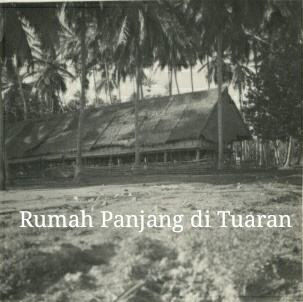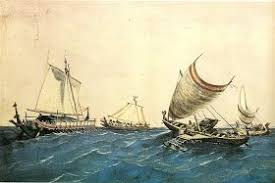EARLY HISTORY, ORAL RECORDS, AND LEGENDS OF THE TATANA TRIBE OF KUALA PENYU
- Marwan Bin Musa
- Feb 26
- 5 min read

Around 2000 years ago, a branch of Austronesian-speaking people arrived at the Klias River and buried their deceased in a cave on Pulau Burong, near Labuan Island. The cave on Pulau Burong is one of the earliest settlements in Borneo and serves as an archaeological site. Studies conducted by Tom and Barbara Harrisson (1971) during excavations in the 1960s discovered remains linked to the "Murut Sandiwar Tribe," suggesting that the Lun Bawang or Bisaya tribes had not yet migrated northward toward Brunei Bay at the time. They believed that the ancestors of the Tatana Tribe, who migrated to Menumbok around 1200 AD, had connections with and possibly intermarried with the Murut Sandiwar Tribe due to linguistic similarities in Murut words such as kanon (rice), monsoi (good), and timug (water) in the Tatana language. Over time, the Tatana Tribe replaced the Murut Tribe in the Menumbok area. In Daly's (1886) records, the tribe residing in Menumbok was referred to as the Punan Tetanah Tribe.
The name "Tatana Tribe" only came into common use around the 1850s. Their original tribal name was possibly Punan, though distinct from the Punan people of Sarawak due to linguistic differences. When the Bisaya Tribe migrated to the Padas River region from their homeland in the upper Belait and Tutong Rivers around 1500 AD, they settled between the Murut Sandiwar and Tatana tribes. The Bisaya language absorbed more Murut words. At one point, the Bisaya Tribe attacked the ancestors of the Tatana Tribe, forcing them to hide in underground holes to escape. Unable to locate the Tatana people, the Bisaya assumed they had escaped and returned home empty-handed.
Eventually, the Tatana Tribe emerged from hiding and found that their enemies had left. From this event, they called themselves the "Tatana Tribe," meaning "from the land," to commemorate their survival. This event took place in the mid-1800s. In Daly’s (1886) records, two tribal leaders, Punghara Kumbang and Punghara Kuntas, emerged from a cave in Tanjung Lumut near the Klias River. These leaders renamed their tribe from Punan to Tatana, as it was customary at the time to change a tribe’s name if the previous one was considered unlucky. Long after escaping from the Bisaya Tribe, the newly recognized Tatana Tribe sent valuable forest products as gifts to the Sultan of Brunei.
Since the Tatana had ceased shipbuilding capable of crossing the seas, they sought help from the Brunei Bisaya Tribe, who frequently sailed in Brunei Bay, to deliver their gift to the Sultan. The Bisaya, who had long coveted Tatana lands, devised a scheme to claim the territory. They swapped the valuable gifts from the Tatana—camphor, gutta-percha, rattan, and beeswax—with inferior forest products before presenting them to the Sultan, claiming they were from the Tatana. Enraged by the poor-quality gifts, the Sultan ordered his warriors to execute the two Tatana leaders. As a result, the Tatana people abandoned their land.
Conflicts over land and territorial disputes among tribes were common in ancient times, as each tribe sought safe and fertile areas. War, such as Misangod Rondom, was not the only means of resolving disputes. Avoiding conflict did not necessarily indicate weakness but rather a different approach to survival. Some claim that the Tatana Tribe abandoned their land, while others argue that they sold their territory—from the Pungharan River to the coast facing Bukit Nouri—to the Bruneians. In the interior, they reportedly sold all Klias River lands to the Bisaya Tribe. However, some believe that the Tatana lands were forcibly taken by the Bruneians and the Bisaya. The Tatana Tribe then migrated to Bundu, Muntabangun, Berabagan, and Mawau near the Kuala Lama estuary at the Padas River’s branch. Others moved to the Prussock River area in the upper Membakut River. The Bundu Klias people are not related to the Bundu Tribe from Bundu Tuhan; rather, they are part of the Tatana Tribe.
Many members of the Tatana Tribe acknowledge having Chinese ancestry. During Chinese New Year, they affix Chinese calligraphy at their front doors. Some Tatana homes have altars and images of good and evil spirits similar to Chinese traditions. In Daly’s (1886) records, he narrated a legend about the first Chinese settlers in Bundu, Kuala Penyu, as told by the elders.
In ancient times, a Chinese trading ship carrying porcelain, silk, and preserved fruits sailed from China to Brunei. The crew was captivated by Brunei’s fertile lands. Led by a man named Si Lasak, some crew members decided to abandon the ship and settle along the Klias River. They began cultivating white pepper and intermarried with the early Dusun inhabitants. Si Lasak himself married the daughter of a Dusun chief. He established a large pepper plantation and sent a ship back to China to bring more friends and relatives to his settlement. They arrived with fine fabrics, cooking utensils, tea, ginger, and other goods. Eventually, Si Lasak was appointed as the leader of the early Dusun people in the Klias River region, earning the title Orang Kaya from the Sultan of Brunei.
After Si Lasak’s passing, tragedy struck when the Murut Tribe attacked their settlement, killing many inhabitants. This was followed by a great flood from the Padas River, submerging the Klias River banks and destroying the white pepper plantations. To escape further Murut attacks and natural disasters, the early Dusun people of the Klias River decided to relocate to higher ground near the coast, selecting Bundu in Kuala Penyu as their new settlement. There, they cultivated rice and re-established white pepper plantations, which flourished.
Two of Si Lasak’s descendants were later granted noble titles by the Sultan of Brunei: Orang Kaya Sabandar Ah Koon and Orang Kaya Sabandar Tenguan. Ah Koon had a son, Orang Kaya Sabandar Makang, who fathered Orang Kaya Sabandar Rinjewar, a well-known chief of Bundu and later a Native Chief. Tenguan’s son, Orang Kaya Sabandar Ak Soon, had a son named Orang Kaya Kimsoy.
Kimsoy’s ancestral home, made of timber, is said to have stood in Bundu for over 150 years. This legend suggests that the early Dusun people of the Klias River and Bundu, Kuala Penyu, were indeed the Tatana Tribe. Chinese immigrants who settled in Kuala Penyu had customs like placing sugarcane at their doorsteps, a tradition traced to Fujian, China, during the Taiping Rebellion (1850–1864). Some of these settlers also came from Guangdong.
With permission and sincere apologies, this is shared as a historical narrative (Joy Marius JM).
Sources: Daly (1886), Borneo Herald (1886), Tom and Barbara Harrisson (1971), Anon (1995), PS Shim (2007), Azlan Mohd Jaffar (FB 2017)
Compiled and Edited by: Kumis Kumis
Illustration: National Archives (Drawing of a Parang that belonged to W.H. Treacher, 19th-century Acting Governor of Labuan).







Comments